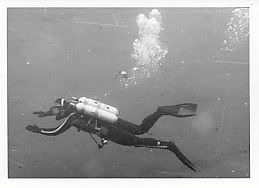And for the 50 year old overweight out of shape person there would always be the standard PADI class for them.
But if someone flashed a plus card on a dive boat when it was sign up time, that plus card would really mean something. The way I think it should be would be to have open water, advanced, rescue, freediving, some DM stuff, and a whole lot more all in one class. It would be better for the agency because they would be getting more money right off the bat and they would have some very happy students (the ones who passed) The ones who didn't, oh well, there's always regular open water. One problem I see would be to find instructors to fill the positions that would be able to do the stuff themselves.
I know that if they offered such a thing when I got certified I would have been all over it, especially if they expplained it well and showed me the differences.
Even now, I hear about stuff they've eliminated from when I got certified and I can't believe it! I got certified in '98 so I'm still a baby in the diving world.
I don't know how much further down they think they can take it. Eventually I would think somebody would get the bright idea to restore training as a sales edge.
Quality training, wow! what a concept!
It use to be this way. In-fact when diving wasn't that big (in Canada at least), it wouldn't be the name of the agency (some instructors weren't certified), but the name of the instructor that counted the most. That's almost something that's beyond comprehension now.
When I became an instructor in 1971, the Basic Diver course required diver rescue as part of the program (there were no "rescue" courses then). Most agencies have still retained submerged victim rescue in their initial program. There wasn't the delineation of depth either. The sport limit was 130', so divers were certified believing that 130' was within their diving envelope on the first day they were certified (although we strongly recommended them to gain experience first). The "Advanced course" often involved: deep diving (120-130'), night diving (or limited visibility) and an overhead environment such as a wreck, or ice (there were no "specialties"). If a diver wanted to use a dry suit, they wore one and figured it out in the water.
PADI saw the "benefit" of splitting up the regular certification program into smaller modules; which bred the "easy road" to certification with a much shorter time commitment. Other agencies went along lowering their standards for certification to get a piece of the new market. Other agencies didn't.
When I owned an LDS, it was an uphill battle to "sell" a longer program to some customers. Fortunately, I taught (and still teach) in close proximity to a military base, so lots of fit young men and women who want to learn (and love a challenge), seek-out training that's more demanding of them. I teach recreational diving in a slightly toned-down way, as I have taught in the Navy and Commercially. Fun is experienced, but it's secondary. They are there to learn and are physically and mentally challenged: developing in-water endurance, snorkel skills, doff & dons, blackout & bailout drills (with mild harassment). Divers have to complete a CESA in o/w from 50' and 100' for "advanced". It's certainly not the type of program for the average person, but it fits the bill for a certain segment of the market.
Like you said, people have a choice. I don't mind how people decide to be trained, but I do expect all divers to have a reasonable degree of competence before they are certified. Unfortunately, this isn't always the case.




 , they really need to think about doing something like this because it's gotten rediculous.
, they really need to think about doing something like this because it's gotten rediculous.

